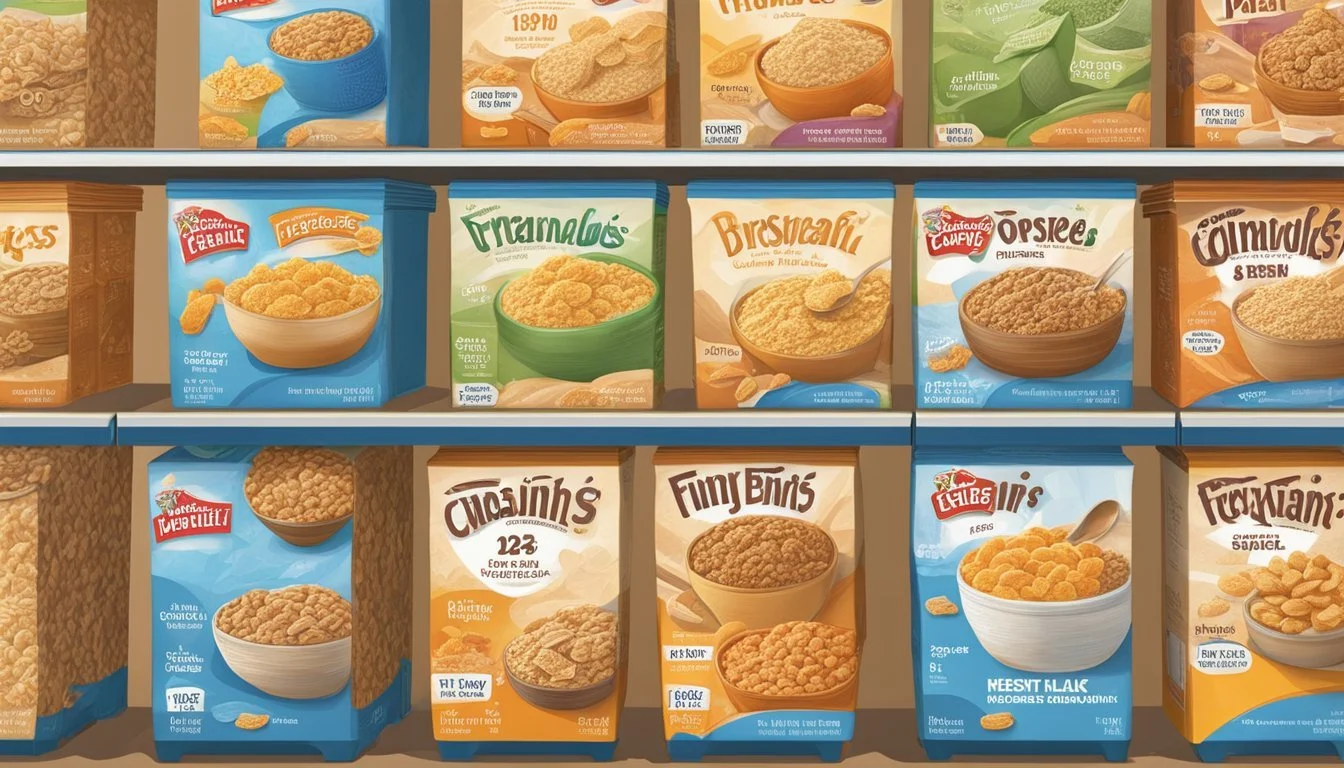All-Bran vs Frosted Flakes
Nutritional Comparison and Health Impact
This Article is Part of Our Breakfast Cereal Guide with Details on All-Bran Nutrition and Frosted Flakes Nutrition
When considering a healthy breakfast choice, cereal often comes into the spotlight. All-Bran and Frosted Flakes are two popular options that offer distinct nutritional profiles. All-Bran provides 7.0 grams of complex carbohydrates per serving, while Frosted Flakes doubles that with 14.0 grams, making All-Bran a better choice for those focusing on complex carbs.
Comparing protein content, All-Bran contains 14 grams of protein per 100 grams, which is approximately 18.7% of the daily value (DV). Frosted Flakes, on the other hand, tend to be lower in protein content. This difference highlights All-Bran's advantage for those looking to increase their protein intake in the morning.
Frosted Flakes appeal to those with a sweet tooth, featuring a higher sugar content. For those aiming to minimize sugar while maximizing fiber and protein, All-Bran stands out as the superior choice. Each cereal has its place depending on individual dietary goals and tastes.
Overview of Cereals
Breakfast cereals have varied histories and types, each offering unique nutritional profiles and consumer experiences. This section will explore the origins and different kinds of cereals, focusing on All-Bran and Frosted Flakes.
History and Popularity
All-Bran, produced by Kellogg's, was introduced in 1916 as a high-fiber option. It quickly gained popularity among health-conscious consumers. Frosted Flakes, another Kellogg’s product, debuted in 1952, targeting a younger audience with its sweet flavor.
Corn Flakes, also from Kellogg’s, were released in 1894 and are one of the earliest cereals on the market. Bran cereals, generally known for their high fiber content, have consistently appealed to those seeking digestive health benefits.
Types of Cereals
All-Bran and Bran Cereal are rich in dietary fiber, essential for digestive health. They contain higher protein content compared to many sweetened cereals, making them a nutritious option for breakfast.
Frosted Flakes and Corn Flakes are made from corn. Frosted Flakes are sweetened with sugar, appealing mainly to children and those with a preference for sweeter cereals. Corn Flakes, though less sweet, serve as a versatile base for various breakfast recipes.
These cereals offer varied nutritional benefits, from high vitamin content in Frosted Flakes to the fiber-rich profile of All-Bran.
Nutritional Comparison
Both All-Bran and Frosted Flakes cater to different nutritional needs, with significant differences in their macronutrient profiles, vitamin and mineral content, and caloric values.
Macronutrient Profile
Protein
All-Bran contains 14g of protein per 100g, which is approximately 18.7% of the daily value (DV). Frosted Flakes, on the other hand, contain significantly less protein, with only about 2g per 100g.
Fats
All-Bran is low in fat, with about 2g per 100g, while Frosted Flakes also has a low-fat content but tends to have slightly less at around 1g per 100g.
Carbohydrates
Carbohydrates are more prominent in Frosted Flakes, containing 84g per 100g. All-Bran, being a high-fiber cereal, contains about 50g of carbohydrates per 100g, much of which is from fiber.
Fiber Content
A notable difference is the fiber content. All-Bran offers a high fiber content of about 30g per 100g, making it an excellent choice for those looking to improve digestive health. Frosted Flakes contain negligible fiber.
Sugar Content
Frosted Flakes have a high sugar content, with about 37g per 100g, while All-Bran contains around 18g of sugar per 100g.
Vitamins and Minerals
Iron
All-Bran is rich in iron, with about 14mg per 100g, which is roughly 78% of the DV. Frosted Flakes contain about 8mg per 100g.
Calcium
Frosted Flakes often have added calcium, providing around 350mg per 100g. All-Bran offers about 60mg per 100g.
Vitamin D
Fortified cereals like Frosted Flakes contain about 2µg of Vitamin D per 100g. All-Bran offers around 1µg per 100g.
Vitamin B6 and B12
All-Bran provides 2mg of Vitamin B6 and 2.5µg of Vitamin B12 per 100g. Frosted Flakes contain slightly less, with 1.7mg of Vitamin B6 and 2µg of Vitamin B12 per 100g.
Zinc, Phosphorus, and Magnesium
All-Bran also has higher amounts of essential minerals. Zinc is around 5mg per 100g, phosphorus at 750mg, and magnesium at about 160mg. Frosted Flakes contain about 1.5mg of zinc, 300mg of phosphorus, and 50mg of magnesium per 100g.
Caloric Values
Calories per Serving
All-Bran has about 70 calories per serving (30g). Frosted Flakes contain significantly more calories, rounding about 110 per serving (30g).
When considering serving sizes, All-Bran tends to be lighter and less calorie-dense, allowing for substantial nutrient intake with fewer calories. Frosted Flakes provide more calories, mainly from sugars, contributing to its higher energy content.
Health Benefits and Drawbacks
Comparing All-Bran and Frosted Flakes reveals significant differences in terms of health benefits and drawbacks. The sections below dive into aspects such as digestive health, weight management, and sugar impact.
Digestive Health
All-Bran is notably high in dietary fiber, offering substantial benefits for digestive health. Fiber helps to regulate bowel movements and reduce constipation. For each 100 grams, All-Bran contains about 14 grams of fiber.
Frosted Flakes, on the other hand, provide significantly less fiber. Its low fiber content means it offers minimal support for digestive health. Consuming Frosted Flakes does not contribute much to daily fiber intake and may lead to digestive irregularities if not supplemented with other high-fiber foods.
Weight Management
All-Bran can be a useful part of a weight-loss diet due to its ability to increase satiety. The high fiber content helps individuals feel full longer, potentially reducing overall calorie intake. With 110 calories per 1.25-ounce serving, All-Bran also fits well into a controlled calorie diet.
Frosted Flakes are less ideal for weight management. The cereal has a higher calorie content, primarily from added sugars. It may lead to quicker hunger pangs and increased calorie intake throughout the day. Frosted Flakes lack the substantial fiber needed to enhance feelings of fullness.
Sugar Impact
A critical drawback of Frosted Flakes is its high sugar content. This cereal often uses sugars like honey, brown sugar, fructose, and glucose to enhance taste, but this significantly increases its glycemic index. High sugar consumption can lead to spikes in blood glucose levels, posing risks for diabetes and heart disease.
Conversely, All-Bran has low sugar content, making it a healthier option for maintaining stable blood sugar levels. It uses fiber to slowly release sugars into the bloodstream, thereby avoiding sudden spikes. This feature makes All-Bran better suited for individuals monitoring their sugar intake.
Taste and Texture Profiles
The taste and texture profiles of All-Bran and Frosted Flakes set them apart significantly, influencing consumer preference and dietary choices. Key differences in flavor variations and cereal texture make each suitable for different tastes and needs.
Flavor Variations
All-Bran has a earthy and wholesome flavor. It's often enjoyed by those seeking a natural and less sweet cereal experience. The bran provides a slight nutty taste, making it stand out among other breakfast options.
Frosted Flakes, on the other hand, boasts a much sweeter profile due to its sugar coating. This cereal is typically preferred by those who enjoy a sugary start to their day. The sweetness can be attributed to the frosting on each flake, which is sometimes enhanced with hints of honey or cinnamon.
Cereal Texture
The texture of All-Bran is notably rougher and denser compared to many other cereals. Each bite brings a hearty crunch, and the flakes tend not to get soggy quickly in milk. This makes it appealing for those who prefer a firmer texture.
In contrast, Frosted Flakes are thin and crispy. Their light texture is a significant draw, but they do tend to lose their crispness faster when immersed in milk. This crunchiness out of the box is a key factor in its popularity, delivering a satisfying sound and mouthfeel with each bite.
Consumer Choices
Consumers often choose between All-Bran and Frosted Flakes based on their preferences, dietary needs, and desired nutritional benefits. These choices can vary greatly depending on how the cereals are served, customized, and any dietary restrictions or considerations.
Serving Suggestions
Both All-Bran and Frosted Flakes can be enjoyed with a variety of additions. Serving suggestions include pairing them with milk, yogurt, or plant-based alternatives. Adding fresh fruit like bananas or berries can enhance the flavor and nutritional value.
All-Bran: Often enjoyed with milk or yogurt, it pairs well with fruits like bananas and berries to add sweetness and texture.
Frosted Flakes: Commonly served with milk, Frosted Flakes can also be enhanced with sliced bananas for added potassium and sweetness.
These simple additions can significantly enhance the breakfast experience and nutritional intake.
Customization and Recipes
Customization offers an opportunity to make breakfast more enjoyable and tailored to individual tastes. All-Bran can be mixed into muesli or granola for a fiber-rich meal. Combining it with dried fruits like raisins or cranberries, and nuts such as almonds and pecans can boost its flavor and nutritional profile.
Recipes: All-Bran can be incorporated into baked goods like muffins or energy bars, providing a unique texture and rich fiber content.
Frosted Flakes: Known for their sweetness, can be used in recipes like banana nut crunch cereal bars or even as a topping for yogurt parfaits.
Each cereal offers versatile options to keep breakfast exciting and nutritious.
Dietary Considerations
All-Bran is high in dietary fiber and has a whole grain base, which can be beneficial for digestive health and is often chosen by those looking to increase their fiber intake. Frosted Flakes, on the other hand, contain more sugars, which some consumers might want to limit.
Dietary Fiber: All-Bran provides a significant amount, which can aid in digestion.
Gluten-Free: Neither All-Bran nor Frosted Flakes are gluten-free, which is a consideration for individuals with gluten sensitivities or celiac disease.
Both cereals cater to different nutritional needs and preferences, allowing consumers to choose based on their specific health goals and taste preferences.
Market and Pricing
When evaluating the market and pricing of cereals such as All-Bran and Frosted Flakes, it's important to consider both the brand comparisons and cost analysis.
Brand Comparisons
All-Bran and Frosted Flakes are both popular cereals with distinct target markets. All-Bran is often chosen by consumers seeking high-fiber options, appealing to health-conscious buyers. Frosted Flakes, on the other hand, attracts those who prefer a sweeter taste, often appealing to children and those seeking a more indulgent breakfast option.
Raisin Bran offers another alternative in the market, positioning itself as a balance between fiber and sweetness. Fiber One and Market Pantry also serve niche audiences, with Fiber One focusing heavily on maximizing dietary fiber intake.
Cost Analysis
The pricing of cereals can vary between brands and retail outlets. Average prices are often determined by factors such as ingredients, brand reputation, and packaging costs. For instance, Frosted Flakes usually commands a slightly higher price due to its brand recognition and flavor profile.
Below is a rough comparison of average unit prices:
Frosted Flakes: $3.74
All-Bran: $4.12
Raisin Bran: $3.89
Premium brands like All-Bran typically cost more due to their nutrient-dense formulations. Store brands like Market Pantry offer more budget-friendly options, albeit with fewer premium ingredients. Such price differences can influence purchasing decisions, especially when buyers prioritize either cost-efficiency or specific nutritional benefits.
Nutritional Insights and Recommendations
Understanding the nutritional content of All-Bran and Frosted Flakes can help consumers make healthier choices tailored to their dietary needs. Key aspects to consider include calorie counts, dietary fiber, added vitamins and minerals, and other nutritional benefits.
Daily Nutritional Goals
All-Bran:
Dietary Fiber: All-Bran offers a substantial 10 grams of dietary fiber per serving, aiding in digestion and promoting a feeling of fullness.
Calorie Count: Contains around 80 calories per serving, making it a low-calorie option.
Protein Content: Provides approximately 2 grams of protein per serving.
Sodium Content: Contains 260 milligrams of sodium per serving.
Frosted Flakes:
Dietary Fiber: Frosted Flakes contains just 1 gram of dietary fiber per serving.
Calorie Count: Higher with about 110 calories per serving.
Protein Content: Similar to All-Bran, it offers around 1 gram of protein.
Sodium Content: Contains 200 milligrams of sodium per serving.
Expert Advice
Nutritionists emphasize the significance of dietary fiber and lower calorie counts for weight management and digestive health. All-Bran is often recommended for its high fiber content, aiding in reducing cholesterol levels and regulating blood sugar.
Vitamins and Minerals:
All-Bran delivers more B vitamins, crucial for energy metabolism, including Thiamin and Niacin.
Frosted Flakes includes added vitamins such as Vitamin C and various B Vitamins, though it lacks the fiber benefits of All-Bran.
Both cereals have their advantages but suit different nutritional needs. A combination or balance depending on individual goals can provide a well-rounded diet.






